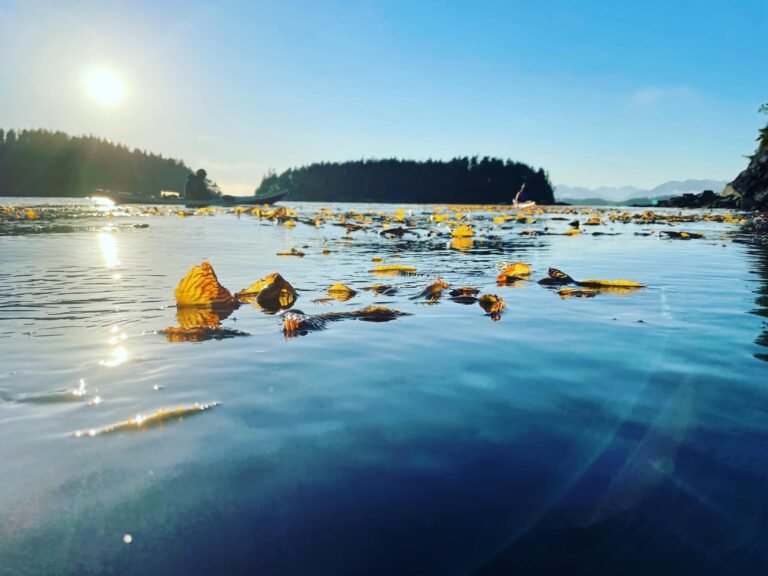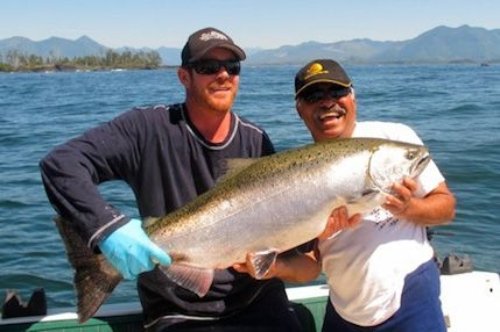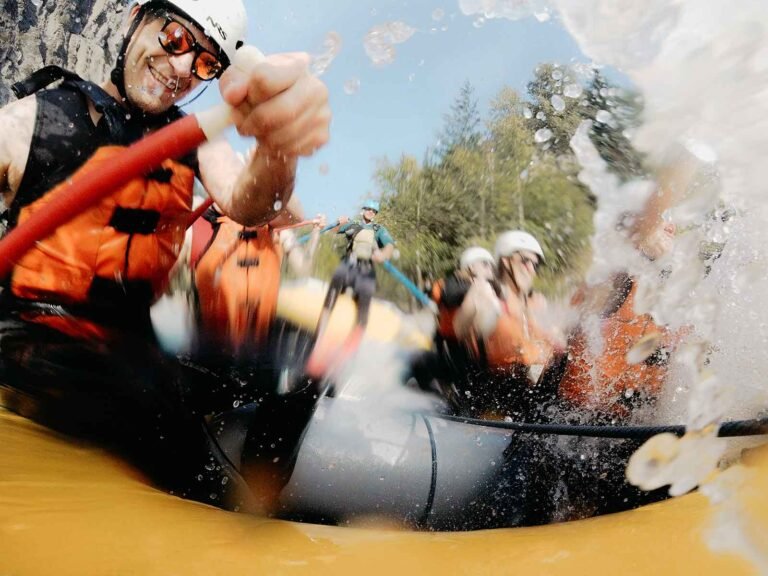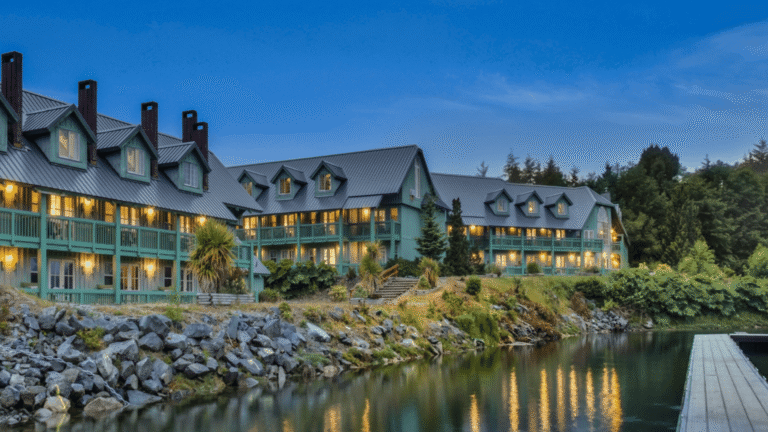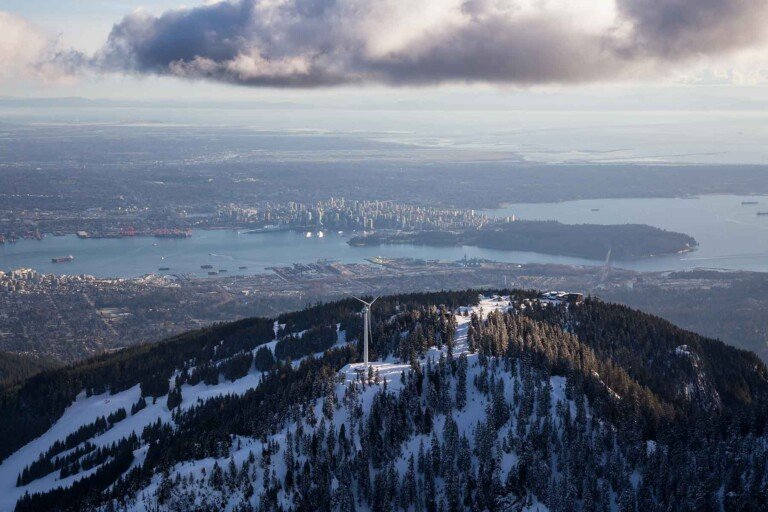Wildlife Viewing Operators: Vancouver, Coast and Mountains
Wildlife Viewing in the Fraser Estuary
Of all the wildlife viewing areas in the Fraser Estuary, none surpasses the George C. Reifel Migratory Bird Sanctuary. Located on the western fringe of the estuary in Delta, Reifel Island and its companion, Westham Island, provide wintering grounds for 230 species of birds. Many of these are nesting residents, such as Canada geese, ducks and teals, marsh hawks, coots, blackbirds, gulls, and doves. Some stay year-round, while others head north to their summer nesting grounds. For example, 20,000 snow geese, one of the largest birds at Reifel, winter here from October to March before heading to Wrangel Island (Ostrov Vrangelya), off the coast of northeastern Siberia. Fall and winter are the best seasons to visit the Reifel sanctuary, before the bird population begins to thin out. A simple network of trails leads around the island and connects with a series of blinds from where you look on in hushed silence as the birds go about their business. For a peek at the action from on high, seek out the 3-storey observation tower at the north end of the island. As you may find the breeze out here a touch chilly, the sanctuary thoughtfully provides a warm-up cabin next to the entrance, where a cheery fire blazes in colder months.
Reifel and Westham Islands are in Delta, about 6 miles (10 km) west of Ladner. Follow the signs to Ladner from the Hwy 99/Hwy 17 interchange. A roadside marker on Hwy 17 S indicates the turnoff to the Reifel Sanctuary on Ladner Trunk Rd (48th Ave). Turn right here. Once you reach the heart of Ladner, stay on the Ladner Trunk Rd as it crosses Elliot St (also called 47A Ave) and leads to River Rd W. Follow along this diked road past floating houses and marinas to a small wooden bridge that leads to Westham and Reifel Islands. Traffic etiquette when crossing the one-lane span gives those driving onto the island the right of way.
With Canada geese populations very much on the rebound these days, it’s hard to believe that they were threatened in the 1960s. One of the places where the honkers began recolonizing the Lower Mainland was at Serpentine Fen, located at the east end of Mud Bay in Surrey. (On the geological evolutionary scale, fens lie between swamps and bogs.) Watch for a tall wooden observation tower that stands out on the east side as Hwy 99 passes over the Serpentine River. Farther east you can see yet another of these. Exit Hwy 99 at Crescent Beach and head north on Hwy 99A (King George Hwy) for a short distance to 44th Ave. A garden nursery is located at this junction. Turn left and drive in to the parking lot and picnic area. The towers aren’t hard to find because they are the tallest structures on the fen. Together, the two observation towers are located at the Serpentine Wildlife Management Area, where Ducks Unlimited released 260 Canada geese in 1972. A series of trails loops around ponds that were created with funds from the Sportsmen of Northern California and the British Columbia government. The refuge provides sheltered nesting grounds for the fat ducks and geese that winter locally. A grove of trees protects several picnic tables from the breeze that often blows in off nearby Mud Bay. The main trail begins here and leads out to the nearby observation towers.
Tynehead Regional Park is a refuge for local wildlife such as coyotes, rabbits, and salmon fry in rapidly developing Surrey. It’s easy to find and easier still to explore. As Hwy 1 leads east of the Port Mann Bridge, take the 176th St exit south and make the first turn west on 96th Ave. From here you have a choice of two approaches. Either turn right at the next major intersection, 168th St, and drive to a park entrance at the road’s north end, or continue west on 96th Ave to another entrance beside the Tynehead Hatchery. Operated by the Serpentine Enhancement Society, a volunteer organization, this is the site of a fish release that occurs each spring as part of the Salmonid Enhancement Program. Come fall, you can see salmon migrating to spawning beds in the park. Another section of the park features a garden that is designed to attract butterflies. Hedgerows line the borders of the park’s more remote corners, excellent locations to look for some wildlife stalking in the tall grass.
Salmon also spawn in Surrey’s Campbell River in autumn. Visit the Campbell River fish hatchery in September and October for an intimate insight into the effort being made to restore declining salmon runs (you can see salmon being milked for their eggs). The hatchery is on the east side of 184th St between 16th and Eighth Aves. If it were summer year-round, Boundary Bay Regional Park in Delta might lose some of its seasonal appeal to migratory birds. The bay is one of the most important stops on the Pacific Flyway. Each spring and fall, more than 250,000 birds pass through the area – between 20,000 and 30,000 brant alone. Together with the sight of the annual salmon migration in the nearby Fraser River, this north-south passage is one of the most stimulating natural events in the region. Throughout the year, the Friends of Boundary Bay run numerous natural-history interpretive programs in the vicinity of the bay and nearby Burns Bog.
A dike trail follows the perimeter of the bay from Boundary Bay Park east to Mud Bay. There are many good viewpoints for birding along the way. Drive to the south end of 64th or 72nd Ave from Ladner Trunk Rd, and walk up onto the dike from here. This is the Boundary Bay Regional Trail, all 12 miles (20 km) of which is public park. In winter, watch for snowy owls – they are often seen sitting motionless on fenceposts. Or a pair of oval-faced barn owls may fly overhead. There’s always magic at work on the shoreline and in the skies above Boundary Bay. Just as at Boundary Bay, the birdlife viewing at Iona Beach Regional Park in Richmond is exceptional, with its own resident population of rare birds such as the burrowing owl and the yellowheaded blackbird. In fact, more rare birds are seen here than anywhere else in the province. Walk through the sand dunes that characterize much of the island, keeping your binoculars at the ready. You’re bound to spot great blue herons as they stalk the shore of Mchttps://britishcolumbia.com/wp-content/uploads/2020/07/discovery-islands-lodge-1-accommodation-quadra-island-british-columbia-1.jpg Slough or in the marshy areas of the island. Throughout the year, GVRD Parks offers special bird-watching programs.
A whale observation tower at Lighthouse Park in Point Roberts, Washington, rises above an interpretive display on orcas. There are three black-finned pods that frequent the park’s offshore waters from May to October. Even if the pods aren’t passing at the time of your visit, you can still learn a lot about the locals from the display.
Wildlife Viewing in the Fraser Valley
North Fraser Valley
Tranquillity reigns in Coquitlam’s Minnekhada Regional Park, a haven just beyond the urban sprawl that threatens to engulf much of the lower south-facing slopes nearby on Mount Burke and Coquitlam Mountain. Tucked in behind several large knolls on the west side of Pitt River, Minnekhada Regional Park shares a common border with the eastern portion of the Pitt-Addington Marsh Wildlife Management Area. Rural charm flows easily from one into the other. Minnekhada is characterized by two large marsh areas that are bisected by a dike and surmounted by two distinctive, rugged knolls. Trails ring the marshes and thread through the surrounding forest. In fall, this is a moody environment. The forested slopes of nearby Mount Burke capture clouds that often don’t burn off until late in the day, if at all. Patches of bright red and gold leaves flare against this pale backdrop. To reach Minnekhada, turn north off Hwy 7 in Port Coquitlam at Coast Meridian Rd. A GVRD sign near the intersection with Apel Dr points the way to the park, a 10-minute drive. There are three entrances to the park. On its south side, Oliver Dr passes through farmland to a formal gate where it looks as if a sentry should stand on guard. Minnekhada was once home to British Columbia Lieutenant-Governor Eric Hamber, who built a Scottish-style hunting lodge on the hillside above one pond in the 1930s. An information kiosk is located next to the lodge, as are several picnic tables. A short distance farther east on Oliver Dr is another approach to the park on the PoCo Dike Trail beside the Pitt River. The western entrance to the park is located on Quarry Rd. (Quarry is a continuation of Victoria Dr, reached via Apel.) This approach quickly brings you to the midmarsh area of the park. The nearby ponds are a natural draw with the more than 60 species of birds that pass through the marsh during spring and fall migrations. Don’t forget your binoculars.
When you visit Kanaka Creek Regional Park in Maple Ridge, you may choose to begin from the Bell-Irving Salmon Hatchery, at the 256th St entrance off Dewdney Trunk Rd. An open playing field and picnic tables border the main arm of the creek. The flow of water here is modest compared with that below Cliff Falls, where the creek’s main and north forks merge. Signs at the hatchery detail the work carried on here to rebuild fish stocks in the creek. Since the hatchery opened in 1983, about two million salmon fry – most of them chum, with some coho – have been released.
Cliff Falls lies about 0.6 mile (1 km) downstream from the hatchery. As there are trails along both sides of Kanaka Creek, make a round trip of it. You’ll find one trailhead directly across 256th St from the hatchery and the other a short distance north next to privately owned Kanaka Lodge. Along the way to the falls you’ll discover many inviting approaches to the creek, especially on the north side The trail that follows the south side of the creek involves steeper climbing. Both trails lead through the sheltering forest. Woodpeckers are drawn to this environment, as are a variety of songbirds that feed on the juicy salmonberries. Small amphibians such as rare tailed frogs can be spotted along fern-draped banks of the creek.
The Pitt-Addington Marsh Wildlife Management Area occupies both sides of the Pitt River, adjacent to Minnekhada Regional Park on the west in Coquitlam and Grant Narrows Regional Park on the east in Pitt Meadows. Trails into the wildlife reserve begin from both Minnekhada and Grant Narrows Parks. Observation towers are strategically positioned along the trails in both. Among the rarer species to be seen are the sandhill cranes that nest in the east side of the wildlife reserve.
The fish hatcheries at Weaver Creek and Morris Creek near Harrison Bay are good staging areas for viewing wildlife such as bald eagles and trumpeter swans in winter, and spawning salmon in autumn. This is one of the most unique geological zones in the Lower Mainland. The rounded mountain tops are actually millions of years older than adjacent ranges of the Cascade and Coast Mountains. To reach the hatcheries on Weaver and Morris Creeks, turn north off Hwy 7 at Harrison Bay on the Morris Valley Rd. Follow paved Morris Valley Rd east to where it divides: one branch leads east to Weaver Creek while the other leads to Morris Creek. Both hatcheries are well signed.
If you camp at Deer Lake in Sasquatch Provincial Park, watch for white-coated mountain goats on the steep-sided slopes of Slollicum Bluffs that rise above the lake’s north side. Early in the morning is the best time to see them as they pick their way along the bluffs. During the hottest times of the year they may even descend to drink from Deer Lake. And keep your eyes open, too, for the park’s namesake.
South Fraser Valley
Skagit Valley Provincial Park finally got its due in 1996 when it was granted full park status. The struggle to save critical sections of the park began in the early 1970s. William ‘Curly’ Chittenden, a Fraser Valley logger and one of the chief proponents for conserving the valley, lived just long enough to receive word of the Skagit’s official protected designation before his death at age 88. A special section of the valley, Chittenden Meadows, honours his commitment to save a rare stand of ponderosa pine trees located here. A self-guided nature walk leads through the meadows. An informative guide is provided at the kiosk located beside a nifty suspension bridge that takes visitors across the Skagit River to Chittenden Meadows. You can learn more about wildlife in the Skagit Valley at the park’s entrance. An interpretive information sign posted there describes in detail the importance of the Skagit to more than 250 species of animals, including mammals, reptiles, and birds. The unique topography of the valley, where the Coast and Interior biogeoclimatic zones converge, is also explained. One of the more intriguing species of wildlife to watch for is the rubber boa constrictor. True to its name, the harmless little boa, the size of a small garter snake, resembles a coiled piece of inner tube, rounded at both ends.
Wildlife Viewing on the North Shore
The Capilano River Fish Hatchery in Capilano River Regional Park teems with piscicultural activity year-round. The best part about it is that visitors get to spy on the fry through glass walls that surround their tanks. It’s like a giant aquarium set in a rock canyon.
The Seymour River Hatchery in the Lower Seymour Conservation Reserve has ponds full of coho and steelhead fry beside Hurry Creek. You’ll have to make your way almost to the Seymour Dam to see them. By then you’ll need a break. Follow the trail from the hatchery to the river, where you’ll discover a sweet little beach offshore by which the fry school when first released in spring. Come summer, you can even take a dip with them!
In 1993, Whytecliff Marine Park became Canada’s first Marine Protected Area. Harvesting or collecting any marine life beneath the waters of this sanctuary is prohibited. Upwards of 200 marine animal species, with exotic names such as the speckled sanddab or the sunflower seastar, call these waters home.
Wildlife Viewing in Whistler and the Sea to Sky Highway
In spring and fall, the Squamish Estuary provides a rest stop for migratory birds. In winter, the moderating influence of Howe Sound’s ocean waters keeps much of the estuary ice-free. Elegant trumpeter swans spend the winter here, as do regal bald eagles. Bundle up and take a walk to see them.
Winter is the best time to walk the dike trail in the Brackendale Eagle Reserve, located farther north on the Squamish River. Short days and low light create an austere atmosphere. Eagles gather in the bare branches of the black cottonwood trees that tower above the Squamish River. The trees stand some distance away on the far shore, across the wide, milk-grey waters. Some trees are decorated with a dozen or more eagles, mute and motionless. As your eyes scan the forest perimeter, you can make out hundreds of such shapes. Although many of the eagles will head north in summer, others nest here year-round, as the bundles of twigs that bulge out near the tops of some of the cottonwoods attest. Equally at home here are the skittish glaucous gulls. If it’s a lean winter, their carcasses are just as likely to be on the menu as the salmon carrion left from late fall coho runs on the Squamish River. In the early morning hours, before the daily arrival of bird-watchers, eagles frequent the banks on both sides of the river. Once the admirers appear, the eagles put the river between themselves and the gawkers.
Over the past 20 years, Brackendale sculptor Thor Froslev has led the fight for the protection of the Squamish winter eagle habitat. Six of his large wooden carvings, on which the aristocratic profile of an eagle is represented, stand at strategic points in the vicinity of the birds’ winter home, including on Hwy 99. In 1996, the BC government announced the creation of a 1,482-acre (600-ha) sanctuary for the eagles, which can number more than 3,769 in winter. Froslev has now turned to monitoring the health of the Squamish River. Without healthy salmon runs, there would be far fewer eagles drawn to feed in this relatively small but vital stretch of water. Froslev maintains his vigilance from his home in the Brackendale Art Gallery, which he established in 1969. Located on Government Rd several kilometres north of the dike where most eagle viewing takes place, he has assembled a coterie of artists to conduct workshops and concerts, with the eagles and river as the core theme. As well, the Brackendale Gallery offers daily walking tours, led by naturalists, of the prime eagle-viewing areas. The gallery also arranges river tours that give visitors a chance to see eagles in more secluded habitats such as nearby Baynes Island.
Wildlife Viewing in Pemberton and Lillooet
Sweet and petite, One-Mile Lake in Pemberton has a boardwalk that runs across its marshy north side. From here, it’s possible to quietly watch birds, particularly during migration season. This can begin as early as April, when larger birds such as trumpeter swans make an appearance. For the most part, though, it’s mergansers, mallards, and loons, while in the surrounding forest, songbirds and hummingbirds work the woods.
Beginning in late August and early September, spawning salmon, which have made their way up the Fraser, Harrison, and Lillooet Rivers, begin the last part of their journey in the Birkenhead River. The sockeye run is particularly spectacular: the river turns red with them. The sight is so remarkable that at first you can hardly believe your eyes. Salmon also run in Gates Creek, which flows into the south end of Anderson Lake in D’Arcy. The Birkenhead River is easily spotted from either Hwy 99 as it passes through rural Mount Currie or numerous places along the D’Arcy-Anderson Lake Rd, including the Owl Creek Forest Service site.
The Upper Lillooet Headwaters is now a protected area, which must come as a relief to the wildlife that have been pushed farther and farther north as logging destroyed lower stretches of critical shelter. Without the forest, animals that come down from higher elevation cannot survive the coldest days of winter. Moose, deer, bear, wolf, and others leave their prints on the silty sandbars that stand revealed at low water levels, and slip mutely through the fir, cedar, and pine forest. Although the occasional bear might leave a paw print outside the door of your tent as a calling card, most wildlife prefer to remain well out of sight. Don’t let that stop you from looking for signs of their presence in the landscape. They’re there!
Wildlife Viewing on the Sunshine Coast of BC
Sechelt Peninsula: California and Steller’s Sealions and Harbour Seals gather during winter months at the mouth of Chapman Creek south of Sechelt. Walk out onto Mission Point for the best views. The best approach to the point is from the beach at Davis Bay.
The marshland around Sargeant Bay Provincial Park is an important stopover for waterfowl such as harlequin ducks, Canada geese, and trumpeter swans, as is the upland area for a host of migratory songbirds. Local volunteers have undertaken an ambitious project to restore wildlife habitat around the bay. To reach the park, follow Redroofs Road west of Hwy 101, about 6 km north of Sechelt. You’ll have to watch carefully for the road sign as it is not prominent. Follow Redroofs to Sargeant Bay Park Road a short distance to the undeveloped shingle and sand beach, and begin stalking from here.
Some of the oldest yellow cedar and western hemlock in western Canada grow in the Caren Range, the backbone of the Sechelt Peninsula. Home to the marbled murrelet, a drab, starling-size seabird whose numbers are in as precipitous a decline as the old-growth western hemlock on which it depends. Although most murrelets nest in cliffs and rock walls, the marbled murrelet, having evolved beside the majestic, ramrod-straight, temperate old-growth forest, lay their eggs on the hemlock’s broad, moss-draped limbs.
A bittersweet victory was gained here when the last of the great Caren forest was recently protected as Caren Provincial Park, but not before some of the oldest trees in Canada – in excess of 2,000 years old – were cut, then left to waste!
You’ll have to drive a long way through open hillsides before you reach the shade of the park, but the tranquillity you’ll experience there will be a grand reward. Look for a paved road that begins 13 km north of Sechelt on the east side of Hwy 101, marked by a Wildlife Rehabilitation Centre sign. Drive a father 13 km up what soon turns into the Caren Mainline Forest Rd. Parts of this road are deteriorating, and those with a four-wheel-drive vehicle will have the easier go of it. At the three-way fork in the road, take whichever direction seems best suited to your vehicle. Each leads to the forest, still some distance above.
Malaspina Peninsula: Come fall, many of the streams that feed into Malaspina Strait team with spawning salmon. Depending on the year and the spawning cycle, Lang Creek Hatchery and Spawning Channels, about 22 km north of Saltery Bay, will be thick with returning salmon. The best viewing is right next to the well-marked pullout on Hwy 101. As sure as salmon return to spawn in late summer, so too do raptors and bears follow. Although black bears in the Powell River region tend to frequent the backwoods logging roads, osprey and eagles, otters and pine marten have no fear of approaching the coastline around Sliammon Creek in search of carrion.
Occasionally, even a black bear will put in an appearance. One particularly good viewing spot of both predator and prey is near the Sliammon fish hatchery, about 5 km north of the Powell River bridge.
Sliammon is the site of a native village that has been in continuous habitation for the past two millennia. To reach the hatchery, follow Klahanie Rd, which begins beside the Native handicrafts store of the same name on the south side of Hwy 101. Watch for an enormous eagle’s nest in one of the trees as you near the strait.


